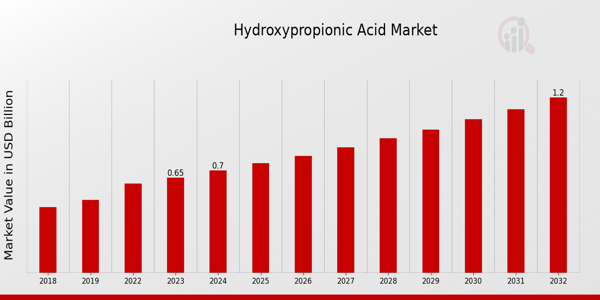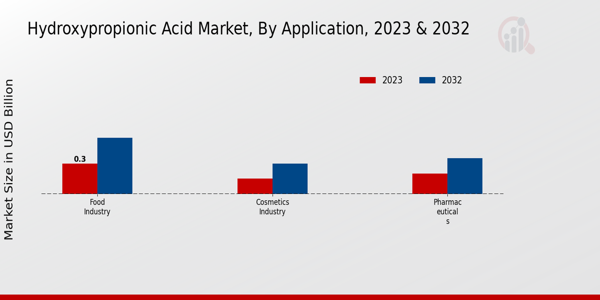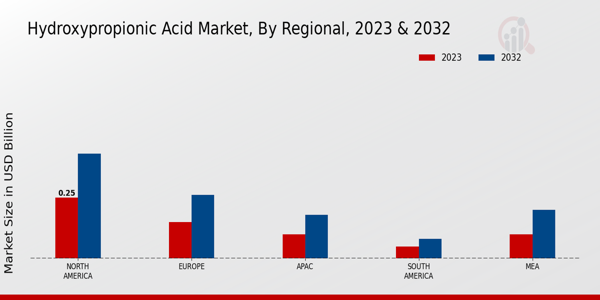Global Hydroxypropionic Acid Market Overview
The hydroxypropionic acid market size was estimated at 0.75 (USD Billion) in 2024. The hydroxypropionic acid industry is expected to grow from 0.80 (USD Billion) in 2025 to 1.47 (USD Billion) by 2034. The hydroxypropionic acid market CAGR (growth rate) is expected to be around 7.0% during the forecast period (2025 - 2034).
Key Hydroxypropionic Acid Market Trends Highlighted
The Hydroxypropionic Acid Market is witnessing significant growth, driven by increasing demand across various industries such as food and beverages, pharmaceuticals, and agrochemicals. Key market drivers include the rising awareness about health and wellness, along with the push for sustainable and bio-based alternatives to conventional chemicals.
This acid's use as a flavor enhancer and preservative in food sectors adds to its attractiveness. Additionally, its potential applications in biodegradable plastics and as a building block for various chemicals create a strong impetus for market expansion.
There are abundant opportunities to be explored within the market, particularly in the area of technology development, to improve production efficiency and reduce costs. The shift toward bio-based production methods aligns well with global sustainable development goals, allowing companies to capitalize on this trend by diversifying their product lines.
Furthermore, emerging markets in Asia and Africa offer untapped potential for the hydroxypropionic acid industry, presenting avenues for growth through local partnerships or market entry strategies.
Recent trends show a growing preference for natural and organic products, influencing consumer choices and encouraging manufacturers to seek eco-friendly production processes. Innovations in formulation and the development of new applications for hydroxypropionic acid in areas like personal care and cleaning products are also notable.
The increasing penetration of e-commerce is altering distribution channels, making it essential for companies to adapt quickly to remain competitive. Overall, the hydroxypropionic acid market is evolving, marked by multifaceted trends and opportunities that present pathways for future development and expansion.

Source: Primary Research, Secondary Research, MRFR Database and Analyst Review
Hydroxypropionic Acid Market Drivers
Increasing Demand for Biodegradable Products
The Hydroxypropionic Acid Market is witnessing a significant surge in the demand for biodegradable products. As environmental awareness increases globally, consumers and industries alike are increasingly seeking alternatives to conventional petrochemical-based products.
Hydroxypropionic acid, derived from renewable resources, offers a sustainable solution that aligns with the shift towards eco-friendly practices. Its applications in various sectors, including cosmetics, food, and pharmaceuticals, highlight its versatility and appeal.
The market's growth trajectory is closely tied to the global push for sustainability as businesses strive to reduce their carbon footprint. Additionally, regulatory measures promoting the use of biodegradable products further bolster demand.
As the market valuation expands rapidly, companies are encouraged to innovate and enhance their product offerings to meet these evolving consumer preferences, driving the Hydroxypropionic Acid Market forward.
Rising Applications in the Food Industry
The food industry continues to be a key driver for the Hydroxypropionic Acid Market. Hydroxypropionic acid serves as a valuable additive in food preservation and flavor enhancement, making it a sought-after component in food manufacturing.
As consumer trends lean towards natural and organic ingredients, the market is witnessing increased adoption of hydroxypropionic acid as a natural preservative. The growing popularity of food products that offer an extended shelf life without compromising quality supports the demand for this compound, providing a significant boost to market growth.
Technological Advancements in Production Processes
Technological advancements in the production processes of hydroxypropionic acid are a major factor contributing to the growth of the Hydroxypropionic Acid Market.
Innovations in fermentation technology and biotechnology have increased the efficiency and yield of hydroxypropionic acid production. These advancements reduce production costs and improve the economic viability of hydroxypropionic acid as a sustainable alternative.
Enhanced production methods also facilitate scalability, enabling manufacturers to meet the increasing global demand. As companies invest in research and development, the resulting improvements in production will significantly impact market dynamics, leading to accelerated growth in the industry.
Hydroxypropionic Acid Market Segment Insights:
Hydroxypropionic Acid Market Application Insights
The Hydroxypropionic Acid Market is experiencing notable growth within the application segment, which encompasses key areas such as the food industry, cosmetics industry, and pharmaceuticals.
A significant portion of this market was attributed to the food industry, valued at 0.3 USD billion in 2023, with projections to grow to 0.55 USD billion by 2032. This sector played a crucial role as hydroxypropionic acid serves as a food additive and preservative, enhancing the taste and longevity of various food products while adhering to health guidelines.
The cosmetics industry also exhibited promising growth, starting at a valuation of 0.15 USD billion in 2023 and projected to reach 0.3 USD billion by 2032. Hydroxypropionic acid's effectiveness as a humectant in skincare and cosmetic formulations makes it a significant ingredient, providing moisture and improving product performance, thus driving its demand in beauty products.
Meanwhile, the pharmaceuticals sector recorded a valuation of 0.2 USD billion in 2023, expected to increase to 0.35 USD billion by 2032. This represents a significant portion of the market, as Hydroxypropionic Acid is utilized in various pharmaceutical applications, including in the formulation of certain medications and as a building block in drug synthesis due to its versatile properties.
These segments collectively illustrate the diverse applications of hydroxypropionic acid in everyday products, reflecting the industry's adaptability to meet consumer needs. The demand across these sectors is driven by trends aiming for natural ingredients and sustainability, which enhances the growth prospect of the Hydroxypropionic Acid Market.
However, challenges remain, including regulatory compliance and market competition, which could impact market dynamics. Despite this, the opportunities for innovation and expansion in hydroxypropionic acid applications in the food, cosmetics, and pharmaceuticals industries are expected to contribute significantly to the ongoing market growth.

Source: Primary Research, Secondary Research, MRFR Database and Analyst Review
Hydroxypropionic Acid Market Form Insights
The Hydroxypropionic Acid Market is experiencing growth driven by its diverse applications in various industries. The form segment, comprising liquid, powder, and granule variants, plays a crucial role in catering to the specific needs of end-users.
Liquid forms are particularly significant due to their ease of use and compatibility with various chemical processes. The powder and granule forms hold a majority market share as they are favored for their stability and enhanced storage capabilities, appealing to manufacturers in the food, cosmetics, and pharmaceutical industries.
Hydroxypropionic Acid Market revenue growth is further influenced by emerging applications and the rising demand for bio-based chemicals. However, challenges such as supply chain disruptions and fluctuating raw material prices may impact overall market conditions.
In exploring Hydroxypropionic Acid Market data, trends indicate a steady increase in usage across sectors, promoting opportunities for growth and development within the form segment as the industry continues to evolve.
Hydroxypropionic Acid Market statistics support the significance of these different forms in addressing the varied requirements of consumers, making them essential for future market expansions.
Hydroxypropionic Acid Market End Use Insights
The Hydroxypropionic Acid Market encompasses diverse end-use applications crucial for its overall growth. In particular, the food additive category plays a vital role as it enhances flavor and stability, indicating its widespread usage in various food products.
The preservative function is equally significant, as it ensures food safety and extends shelf life, thereby becoming a pivotal component in food manufacturing. Additionally, the hydration agent aspect contributes notably to the cosmetics and personal care industry, meeting the rising demand for moisturizing solutions.
The comprehensive Hydroxypropionic Acid Market data highlights the potential for expansion in these segments, driven by consumer preferences for natural additives and increasing health consciousness. The market growth is further bolstered by emerging trends such as sustainable production methods and innovative applications, presenting opportunities for stakeholders.
However, challenges such as regulatory scrutiny and competition from alternative substances may impact market dynamics. Overall, the diverse applications within the Hydroxypropionic Acid Market segmentation suggest a balanced and robust development trajectory.
Hydroxypropionic Acid Market Distribution Channel Insights
The distribution channel plays a crucial role in market access and consumer reach. The direct sales channel stands out as a significant means of connecting manufacturers directly with consumers, ensuring better pricing and product knowledge.
Online retail is increasingly gaining traction, especially in light of shifting consumer preferences towards e-commerce platforms, enhancing market growth and convenience. Wholesale distribution remains a dominant channel, allowing bulk purchasing that benefits both suppliers and end-users, particularly in the industrial applications of hydroxypropionic acid.
Together, these channels reflect the evolving landscape of the Hydroxypropionic Acid Market, creating a dynamic where accessibility and consumer convenience are prioritized, thereby supporting market trends that favor increased product availability and consumer engagement.
The diverse Hydroxypropionic Acid Market segmentation across distribution channels indicates robust opportunities and challenges that stakeholders must navigate to optimize logistics and consumer outreach in the years ahead.
Hydroxypropionic Acid Market Regional Insights
The Hydroxypropionic Acid Market is witnessing a stable growth pattern across various regions, with North America leading the charge in 2023 with a valuation of 0.25 USD billion, projected to reach 0.43 USD billion by 2032, highlighting its majority holding in the market.
Europe followed with significant contributions, registering 0.15 USD billion and expecting growth to 0.26 USD billion by 2032, driven by increasing demand in bio-based chemicals. The APAC region, while valued at 0.10 USD billion, is on a path to reach 0.18 USD billion, reflecting the rising industrialization and awareness towards sustainable products.
In South America, the market stood at 0.05 USD billion in 2023 and is projected to grow to 0.08 USD billion, demonstrating a growing interest in eco-friendly chemicals. Lastly, the MEA region, valued at 0.10 USD billion, is anticipated to expand to 0.20 USD billion.
The diversity in regional demands and applications highlights the opportunity for stakeholders within the Hydroxypropionic Acid Market, fostering innovative solutions in response to localized preferences and challenges, reflected in the regional market statistics and segmentation insights.

Source: Primary Research, Secondary Research, MRFR Database and Analyst Review
Hydroxypropionic Acid Market Key Players and Competitive Insights:
The Hydroxypropionic Acid Market is characterized by a dynamic competitive landscape shaped by several key players striving to strengthen their market share and influence product innovation. Companies in this sector are increasingly focusing on sustainable production practices, positioning themselves effectively to meet the rising consumer demand for eco-friendly products.
As research and development efforts intensify, market participants are working to enhance their product portfolios, improve efficiency, and optimize cost-effectiveness.
The market is also influenced by regulatory frameworks and changing consumer preferences, calling for adaptable strategies that accommodate shifting trends. Collaboration, mergers, and acquisitions are also prevalent as firms seek to expand their geographical footprint and cater to diverse market segments.
Wilmar International is recognized as a significant player in the Hydroxypropionic Acid Market, leveraging its extensive experience in the agriculture and food sectors to enhance its market presence. The company boasts a robust distribution network, allowing it to reach various geographical locations effectively.
With a commitment to sustainable practices, Wilmar International integrates eco-friendly methodologies into its production processes. This focus not only differentiates the company from its competitors but also aligns with the growing consumer inclination toward sustainability.
Moreover, Wilmar International's financial strength empowers it to invest in innovative technologies that streamline operations and improve product offerings. The integration of such strengths positions Wilmar International favorably within the competitive framework of the hydroxypropionic acid market.
NatureWorks is another prominent entity in the Hydroxypropionic Acid Market, capitalizing on its expertise in bioplastics and renewable materials. The company has established a strong foothold through its commitment to sustainability and advanced production techniques, which resonate with a broad spectrum of environmentally conscious consumers.
NatureWorks focuses on establishing long-term relationships with its suppliers and customers, which enhances its market presence and fosters loyalty. The company's ability to produce high-quality hydroxypropionic acid derived from renewable resources sets it apart in a marketplace that increasingly values eco-sustainability.
Additionally, NatureWorks plays a crucial role in expanding the potential applications of hydroxypropionic acid, ensuring its products meet evolving industry standards and customer expectations. By leveraging its strengths, such as innovation, sustainability, and strategic partnerships, NatureWorks continues to be a competitive force within this market segment.
Key Companies in the hydroxypropionic acid market Include:
-
Wilmar International
-
NatureWorks
-
Cargill
-
Tate and Lyle
-
Genomatica
-
BASF
-
DuPont
-
RheinChemie
-
Kraton Corporation
-
Mitsubishi Gas Chemical
-
Evonik Industries
-
SABIC
-
Givaudan
-
Huntsman
-
Corbion
Hydroxypropionic Acid Market Developments
Recent developments in the Hydroxypropionic Acid Market reflect a growing interest in sustainable bioproducts and innovations across major companies. NatureWorks and Cargill have been focused on enhancing production efficiency and expanding their product portfolios, while BASF and DuPont are increasingly integrating hydroxypropionic acid into their various applications in agriculture and bioplastics.
The trend towards greener alternatives is evident as companies aim to meet the rising demand for renewable chemicals. In terms of mergers and acquisitions, there have been notable activities, such as Givaudan's strategic acquisition aimed at bolstering its flavor and fragrance business, which incorporates hydroxypropionic acid in its formulations.
Additionally, Kraton Corporation's focus on bio-based inputs suggests a commitment to expanding its market share in this sector. The continued growth in market valuation of these companies is indicative of a broader acceptance and implementation of hydroxypropionic acid in diverse applications, creating a ripple effect that influences pricing, availability, and technological advancements within the market.
As sustainability becomes crucial, firms like Wilmar International and Evonik Industries are strategically positioning themselves to capture emerging opportunities in eco-friendly formulations.
Hydroxypropionic Acid Market Segmentation Insights
| Report Attribute/Metric |
Details |
| Market Size 2024 |
0.75 (USD billion) |
| Market Size 2025 |
0.80 (USD billion) |
| Market Size 2034 |
1.47 (USD billion) |
| Compound Annual Growth Rate (CAGR) |
7.0% (2025 - 2034) |
| Report Coverage |
Revenue Forecast, Competitive Landscape, Growth Factors, and Trends |
| Base Year |
2024 |
| Market Forecast Period |
2025 - 2034 |
| Historical Data |
2020 - 2024 |
| Market Forecast Units |
USD billion |
| Key Companies Profiled |
Wilmar International, NatureWorks, Cargill, Tate and Lyle, Genomatica, BASF, DuPont, RheinChemie, Kraton Corporation, Mitsubishi Gas Chemical, Evonik Industries, SABIC, Givaudan, Huntsman, Corbion |
| Segments Covered |
Application, Form, End Use, Distribution Channel, Regional |
| Key Market Opportunities |
Bioplastics manufacturing expansion, Growing demand in cosmetics, Increased applications in pharmaceuticals, Rising interest in bio-based solvents, Development of sustainable production methods |
| Key Market Dynamics |
Increasing demand for bio-based chemicals, Growth in cosmetic applications, Expanding pharmaceutical uses, Rising awareness of sustainability, Technological advancements in production |
| Countries Covered |
North America, Europe, APAC, South America, MEA |
Frequently Asked Questions (FAQ) :
By 2034, the Hydroxypropionic Acid Market is expected to reach a value of 1.47 USD billion.
The expected CAGR for the Hydroxypropionic Acid Market from 2025 to 2032 is 7.0%.
By 2034, North America is expected to have the largest market share valued at 0.43 USD billion.
The Food Industry segment of the Hydroxypropionic Acid Market is projected to be valued at 0.55 USD billion by 2034.
The Pharmaceuticals sector is expected to reach a value of 0.35 USD billion by 2034.
Key players in the market include Wilmar International, NatureWorks, Cargill, and BASF.
In 2024, the Cosmetics Industry segment was valued at 0.15 USD billion.
The APAC region is projected to reach a market size of 0.18 USD billion by 2034.
Emerging trends in sustainable production and increased demand for food and cosmetics present growth opportunities.
By 2034, the MEA region is expected to have a market size of 0.2 USD billion.

















